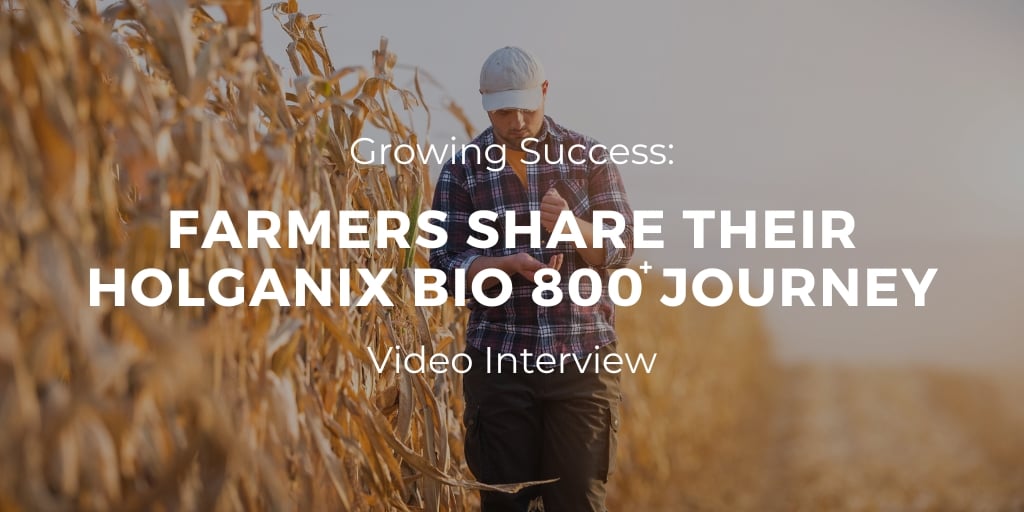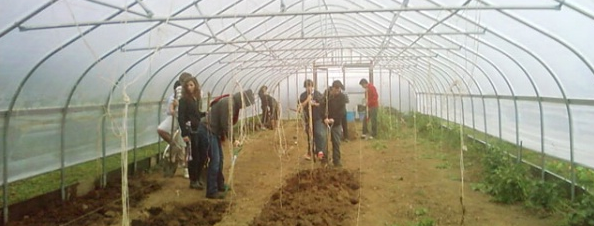 With Holganix Bio 800+ products, “we get high yields and reduced residue issues in the springtime,” explains Tim Varilek, third generation farmer in Southwest Nebraska. “I’ve also reduced my fertilizer by 40% from where I was a few years ago, which pretty much cuts my fertilizer budget in half because of the high fertility costs. It makes me happy and my banker happy.” Tim raises corn, soybeans, popcorn, alfalfa, edible beans and wheat. This is his fifth year using Holganix Bio 800+ products.
With Holganix Bio 800+ products, “we get high yields and reduced residue issues in the springtime,” explains Tim Varilek, third generation farmer in Southwest Nebraska. “I’ve also reduced my fertilizer by 40% from where I was a few years ago, which pretty much cuts my fertilizer budget in half because of the high fertility costs. It makes me happy and my banker happy.” Tim raises corn, soybeans, popcorn, alfalfa, edible beans and wheat. This is his fifth year using Holganix Bio 800+ products.
Tim isn’t the only farmer reporting sweeping fertilizer reductions, among other results, with Holganix Bio 800+ products. Jon Nelson, in Lake Preston, South Dakota, won the 2023 South Dakota soybean yield contest (Group 2, No-till, Non-Irrigation Category) with a yield of 82.5 bushels compared to a county average of about 42. “The beans received less than 10 inches of rain this year, and we used no fertility at all. I just used Holganix and some micronutrients.”
In this blog, Holganix CEO and Founder, Barrett Erseks, sits down with farmers, Tim Varilek (Lemar, Nebraska), Jon Nelson (Lake Preston, South Dakota) and Grant Strom (Dahinda, Illinois) discussing the results they are seeing in the field using Holganix Bio 800+ Agriculture and Holganix Bio 800+ Breakdown. Click the links below to skip to a specific topic or continue scrolling for the full interview.
- What do you do for soil health?
- How has Holganix Bio 800+ Agriculture helped to reduce your fertilizer inputs?
- How has Holganix Bio 800+ Agriculture helped to improve your yields?
- Did you notice any changes in plant health, crop performance, disease, lodging, etc?
- What results have you seen with Holganix Bio 800+ Breakdown?
What do you do for soil health?
Watch the 5.5-minute video above for the interview or keep reading below. If you’re reading this blog via email, click here to access the video clip.
Jon Nelson - “We used to be conventional till, but after seeing what Holganix Bio 800+ Agriculture could do for root growth in one year, we decided to commit to no-till. We sold the tillage equipment, and it’s been really interesting. People talk about there being a 3-to-5 year lag in yield as you move from conventional to no-till, but we haven’t seen that. I really credit that to Holganix Bio 800+ growing the biology faster in our soils. It’s also made our soils more aggregated and, in the process, our bulk densities have really decreased.”
Tim Varilek - “We are working on going no-till. We had been conventional till in the past, but we have moved to strip-tilling. I really found that with the microbial life from Holganix Bio 800+, the time to recover from one tillage pass has been such a huge difference. We also get high yields and less residue issues.”
How has Holganix Bio 800+ Agriculture helped to reduce your fertilizer inputs?
Watch the 7-minute video above for the interview or keep reading below. If you’re reading this blog via email, click here to access the video clip.
Grant Strom - “We have dropped our fertilizer rates pretty significantly. Making fertilizer reductions is one of those things that makes a farmer nervous because of the way we farmers have been taught. Currently, we are using 15% less nitrogen than in years past. We have Holganix pretty much paid for with reductions before harvesting the crop.”
Jon Nelson - “Over the last three years, we have cut back on fertilizer significantly. We reduced nitrogen by 40% and are currently using somewhere between 0.5-to-0.6 units per bushel. We’ve also cut out all dry phosphorus and potassium in our corn and beans. We might put a little bit of potassium acetate if needed on our corn. I haven’t seen any yield decreases despite the reductions. In fact, I continue to see our plants get healthier.”
How has Holganix Bio 800+ Agriculture helped to improve your yields?
Watch the 13-minute video above for the interview or keep reading below. If you’re reading this blog via email, click here to access the video clip.
Jon Nelson - “We are getting 200 bushel of corn this year on corn at 0.5-to-0.6 units per bushel. starting to see two different structures to my beans. I’m seeing a deeper tap root and better nodulation.”
Jon also won the 2023 South Dakota soybean yield contest (Group 2, No-till, Non-Irrigation Category) with a yield of 82.5 bushels compared to a county average of about 42.
Tim Varilek - “The first year we used Holganix Bio 800+ Agriculture, I did half of the land with the product and the other half as a control. I had to recalibrate my monitor just to make sure it was reading properly. The field used to do 130-to-135 bushels, now it’s doing 165.”
“Before Holganix, my organic matter was 0.6-to-0.9, now they are saying it’s at 2%. I don’t know about that reading but it’s downright exciting. I can’t even describe how awesome it has been.”
Grant Strom - “Tougher growing conditions seem to provide a greater yield response with the product. We have good soil here and even our poor conditions are a lot better than what you heard from the other growers in the interview. On average, we get a 3-to-5-bushel advantage on corn, which pays for the product, let alone all the fertilizer reductions.”
Did you notice any changes in plant health, crop performance, disease, lodging, etc?
Watch the 8-minute video above for the interview or keep reading below. If you’re reading this blog via email, click here to access the video clip.
Tim Varilek – “Compaction is certainly a lot less of an issue with Holganix Bio 800+ products. I also use Holganix as a fix on crops that are damaged from wind or hailstorms. I don’t apply fungicides anymore; fungicides just put a band-aid on the problem.”
Grant Strom – “Without question, we see better young growth. We also see larger leaf area, more roots, and plants coming out of the ground faster. It’s no question that we are getting those plants off to a good start.”
Jon Nelson – “Last year we started measuring bulk density. On average, our bulk density averages around 1. If you aren’t familiar with that scale, below 1.1 means the roots have complete access to the soil. That tells me that the biology in Holganix has been improving the soil conditions.”
What results have you seen with Holganix Bio 800+ Breakdown?
Watch the 5-minute video above for the interview or keep reading below. If you’re reading this blog via email, click here to access the video clip.
Grant Strom – "We used Holganix Bio 800+ Breakdown on 1,500-to-1,800 acres this past fall. A week after, we got some decent rains and some warm temperatures, and we really started to see that residue get that black decomposition look to it. You can pull back the residue and see the white fungus, that is a sign that things are breaking down. The year before we struggled with residue issues, so this is a big difference for us.”
Want To Dig In Deeper? Check Out Upcoming Webinar!
Are you looking to maximize the health of your soil? Leveraging soil microbes is the key!
Attend our webinar, hosted by Holganix President of Agriculture, David Stark, Ph.D., in partnership with CropLife, on March 12 @ 2:00 pm Eastern to discuss the role of soil microbes in building soil health.

 |
February 22, 2024
|
2:45 PM
|
February 22, 2024
|
2:45 PM





.jpg)
-4.jpg)
-2.jpg)
-1.jpg)
-1.jpg)
-1.jpg)
.webp)
-1%20(1).webp)
-831535-2.webp)





.png)